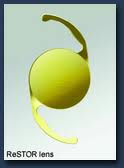Traditionally, when a cataract develops, the eye lens is replaced with an artificial intraocular lens (IOL). The lens is usually focused for distance vision, requiring that the patient need to wear reading glasses or contact lenses to focus in on nearer objects. 
Through recent advancements in lens technology, an IOL is now available that can provide the patient with a greater range of vision while reducing the need for glasses and contacts. The ReSTOR intraocular lens provides a full range of functional vision for patients that desire a significant decrease in their dependence on glasses or contacts.
How ReSTOR® Works
ReSTOR, short for AcrySof® ReSTOR® Apodized Diffractive Optic Posterior Intraocular Lens, replaces the natural lens removed because of cataracts. It has a patented optic design that combines apodized diffraction and refraction technologies for quality vision at both near and far distances. The apodized diffractive optic design gives it the ability to focus light correctly on the retina for images at various distances without mechanical movement of the lens.
Apodization is the gradual reduction or blending of the diffractive steps from the center to the outside edge of a lens; it creates a smooth transition of light between the distant, intermediate, and near focal points. Diffraction involves the bending or spreading of light to multiple focal points as it passes through the lens. The center of the ReSTOR lens surface consists of an apodized diffractive optic. This means that the series of tiny steps in the center area work together to focus light for near through distant vision.
Refraction involves the redirection of light passing through the lens to focus on the retina. The refractive region of the ReSTOR lens bends light to a focal point on the retina. This outer region – surrounding the apodized diffraction center – focuses light for distant vision.
Candidates for ReSTOR® Lenses
Anyone who is dependent on reading glasses or bifocals may be a candidate for ReSTOR implant surgery. Although ReSTOR lenses were originally designed for patients with cataracts, having cataracts is not necessary to qualify for the ReSTOR lens; you only need a desire to restore eyesight at a range of distances without corrective eyewear. People with chronic infections, uncontrolled diabetes, or other health problems may have to wait until these conditions are under control prior to surgery.
Risks and Complications
As with any surgery, ReSTOR lens surgery has potential complications. The most common side effects of all cataract procedures include redness, irritation, light sensitivity, and infection. These risks, however, are rare and are often outweighed by the potential benefits of restoring your vision.
Complications specific to ReSTOR lenses may include glare, blurred vision, and rings around lights. These side effects may make it more difficult to see while driving at night and to complete other tasks in areas with low lighting.
